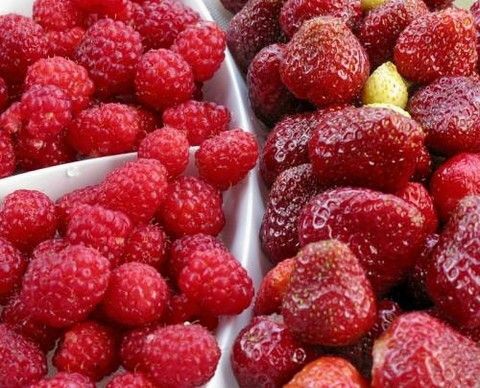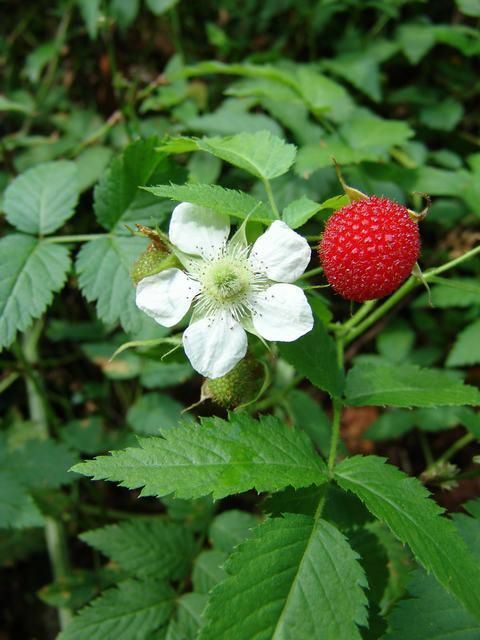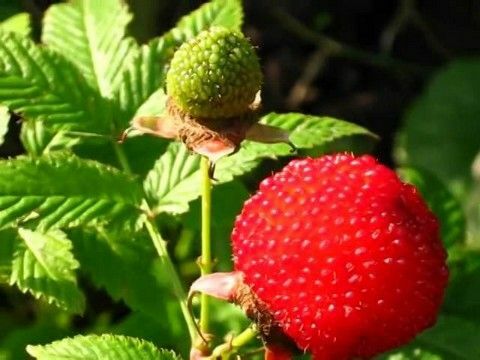Some certainly had to hear about the existence of a hybrid of raspberries and strawberries. Someone even managed to try the fruits of this plant, indeed, unusual in appearance. So do plant breeders have reached such heights in science that they learned how to breed bushes with herbaceous plants? But no, it's still impossible.

The fact that someone is ignorant, and someone and in order to earn more money on the sale of strange seedlings, gives out as a hybrid of two so unlike plants a little-known in our country variety of raspberries. It has many interesting names:
- rosaline or rosewood;
- zemmaline;
- Tibetan;
- strawberry;
- seductive;
- of the club;
- raspberry.
The berries of such unusual raspberries are large, like strawberries, bright, very decorative. They have a fresh strawberry flavor, and the taste is sourish, like a blackberry with pleasant and fresh pineapple notes.
Description of the plant
So, rosolin is a half-shrub originally from East Asia. In nature it occurs in mixed forests and on mountain slopes. In natural conditions, its height reaches 3 meters. However, raspberry, which grows in gardens, is somewhat more modest in size - no more than 1.5 m in height.
The plant is unusually decorative, so it is often used more to decorate household plots than as a fruit crop. Tibetan raspberries are also good for hedges, not only pleasing the look of happy hosts, but also protecting the territory from uninvited guests with fluffy spiny branches.
Leaves
Leaves externally have some resemblance to the leaves of the rose, hence the botanical name of the shrub is raspberry raspberry. They are bright green with yellowish streaks, like corrugated and collected on 5-7 on petioles. In addition, small denticles along the edges give the leaves special tenderness, charm and beauty.
Flowers
Flowers large enough to 5 cm in diameter, single, white, composed of five petals. The flowering of the shrub begins in July and lasts until the fall, with the flowers constantly opening next to the ripening berries.
Fruits
Raspberry strawberry jellies are juicy, bright red, the size sometimes with a walnut. Grow up directed upwards. In form they resemble strawberries and, since they do not hide in foliage, they are very noticeable from afar.
One word "hybrid of raspberries and strawberries" is a low shrub with a rounded crown and beautiful leaves, long-time strewn with flowers and berries, which allows it to play an important role in landscape design, decorating lawns, rock gardens and coniferous plantations.

Spikes
An unusual raspberry has one more similarity with rose bushes, though not the most pleasant - these are large sharp spikes. The plant is very prickly, so work on its planting and processing should be carried out exclusively in dense gloves. And even dry branches can scratch, therefore it is better to burn them as soon as possible on a fire.
Planting and breeding
Plant seductive raspberries on the southern side of the garden in the sunniest areas. In areas with a hot, dry summer, she also tolerates partial penumbra. It can be placed in separate bushes or rows, placing either small trenches in the holes, respectively. In this case, the distance between the bushes should be 0.7-0.9 m, and between rows - at least 1.5 m.
Raspberry strawberry can grow on almost any soil, but prefers fertile and rather loose. Therefore, 1 bucket of peat and 0.5 buckets of manure are recommended for each pit. Also important after planting abundant watering.
Tip. Plant the malignant in the autumn period until the onset of stable frosts( the second half of September - October).It is at this time that the plant is likely to take root in a new place and will not get sick. At the first significant cooling, dip the plant, covering the roots with 30 cm of earth.
Rozalin breeds by root offspring, of whom many grow during the season. The presence of abundant basal grass makes it necessary to choose for a bush a place where raspberries will not interfere with other plants, or limit the space of growth by accessible means( for example, dug up with a slate barrier).
For planting on a new place the root process should only be carefully excavated with a sharp bayonet shovel together with a large clod of earth.
How to care for a Tibetan raspberry?
Rosolistnaya raspberry is unpretentious, nevertheless it needs elementary care. In summer, in dry weather, the bush should be watered regularly, and in the heat it must be done daily, and preferably at night. In addition, to prevent drying, the soil is recommended to mulch, especially when raspberries are planted alone. As mulch it is better to choose peat crumb, compost or humus.
Despite the fact that Tibetan raspberry is hygrophilous, it does not tolerate strong waterlogging and long stagnation of water. It should not be planted in lowlands, where spring melt water gathers or puddles form after a long time of rain.
The root system of strawberry raspberries is located close to the soil surface, so loosening should be done with extreme caution. The same applies to the removal of weeds. Tear them better with their hands, so as not to damage the roots of rosaline, and do not ruin the plant thereby.
Broom feeding is usually carried out in the spring, sprinkling 4-5 table spoons of universal mineral fertilizer without chlorine for each individual of the "raspberry and strawberry hybrid".
Recommendation. Opponents of mineral fertilizers at the beginning of summer need to feed the plant with slurry 2-3 times, for the preparation of which one part of manure and 20 parts of rain water are taken.
The crop is harvested as the berries mature. They are very juicy, have a unique sweet and sour taste, they smell of strawberries. They are used fresh, and also suitable for jams, jams, kissels and compotes. Very rarely cause allergies. They do not tolerate transportation, so they practically do not go on sale.

For the winter, the shoots of Tibetan raspberries completely die. Therefore, after the end of fruiting, the entire above-ground part of the bush is cut level with the ground, and the roots are poured. In the shelter, raspberries only need especially severe and little snow winters. But it tolerates moderate frosts well.
So, we figured out that the existence of a hybrid of raspberries and strawberries - just a beautiful myth, invented by enterprising sellers of planting materials. Nevertheless, the plant is real. And it does not matter what name it is. The main thing is that the unusual bush has many remarkable qualities, and he found his loyal fans among the numerous gardeners and landscape designers. Perhaps, among the admirers, one day you will find yourself.
